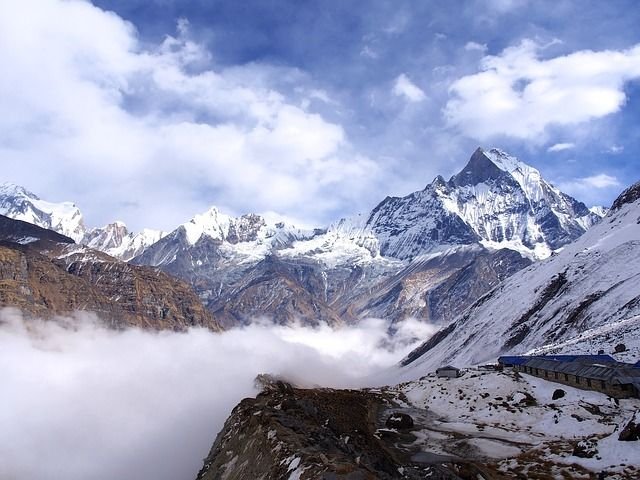Do you know these 13 Unknown Facts About Himalayas? If not, then these facts will surely amaze you. Since it is located in the heart of South Asia, the name Himalaya signifies “Abode of Snow.” Tibetans, Indians, and Nepalese all take pleasure in the Himalayan mountain range. This essay will teach you a variety of fascinating information about the Himalayan mountains.
The Himalayas rise over 7200 metres and span for almost 2400 kilometres. They flow west to east. This is what separates the Tibetan Plateau from the Indian subcontinent.
Mount Everest, the world’s tallest mountain peak, is the Himalayas’ first and most stunning feature. For millennia, Himalayas have been drawing people from all over the world to the Himalayas to marvel at nature’s stunning handiwork. We’ve put up a collection of amazing facts about the Himalayan mountains. The ultimate objective of any climber and trekker is to explore the gorgeous mountain range and reach its apex.
A vast majority of Hindus and Buddhists revere the Himalayas. Here are some unique and fascinating facts about the Himalayan mountains, as well as the snowy summits. Let’s look for 13 lesser known facts about the Himalayan mountains!
Physical Facts About Himalayas
The Himalayan Range is 2400 kilometres long, stretching from west-northwest to east-southeast, with the western anchor at Nanga Parbat and the eastern anchor in Namcha Barwa. The Karakoram and Hindu Kush mountains bound the Northern Himalayas. The Indus-Tsangpo Suture, a 50 to 60-kilometre-wide tectonic valley, separates it from the Tibetan Plateau to the north. The Himalayas face the Indo-Gangetic Plain to the south. The Himalaya ranges in breadth from 350 kilometres in the west to 150 kilometres in the east.
The convergent border between the Eurasian Plate and the Indo-Australian Plate produces the Himalayan Range, one of the world’s youngest mountain ranges. The Indo-Australian Plate began to move north some 70 million years ago. And eventually, it met the Eurasian Plate around 50 million years ago. These two plates then faulted and folded to form mountain ranges. The marine limestone discovered near the summit of Mount Everest, the Himalayas’ highest peak, indicated that the mountain range originated in the ancient Tethys Ocean.
Facts About Himalayas Weather
The Indian plain may retain the monsoon rains, thanks to the Himalayan ranges. And there is only a limited quantity of rainfall on the Tibetan plateau. The glaciers and snowfields atop the Himalaya Mountains’ peaks are the source of Asia’s most major rivers, including the Indus, Ganges, and Yarlung Tsangpo. Many endangered species live in the woods near the foot of the Himalaya on the southern side, including the Snow Leopard, Wild Yak, Himalayan blue sheep, and others.
Facts About The Himalayas Temperature
The Himalayas have a tropical climate as well as an alpine climate. The Himalayan climate is mostly affected by the India monsoon, which occurs from mid-June to the end of September. From the extremely eastern Himalayas to the western Himalayas, it becomes drier and dryer as the monsoon has less of an impact. And, because of the absence of rain, the southern side of the mountain has a lush and wet environment, whilst the northern side is warmer and dryer.
The climate of the Himalaya Mountains separates into two seasons: summer and winter. The average summer temperature in the southern side is roughly 20°C. And the average winter temperature is around 18°C. The temperature of the Himalayas steadily lowers as altitude climbs. At the middle range of the Himalaya Mountains, the average summer temperature drops to 15°C, while the average winter temperature is below freezing. Over 5000 metres, the temperature is always below freezing, and snow covers the mountain top always.
Himalayan Population
Over 50 million people live in the Himalayan range, which includes northeast India, Nepal, Tibet, and Bhutan. The Himalayas are home to Aryans, Mongoloids, and Negroids. Furthermore, 600 million people live in the basins produced by rivers rising in the Himalayas, such as the Indus, Ganges, and Tsangpo-Brahmaputra.
People in different Himalayan areas are affected by diverse cultures and have their own faith and beliefs. Tibetans on Mount Everest’s north slope practise Tibetan Buddhism. The culture of the valleys in the middle Himalayas is comparable to that of Afghans and Iranians. And Nepalese culture is inspired by both Tibetan and Hindu traditions. So visiting India, Nepal, Bhutan, and Tibet will be a once-in-a-lifetime opportunity to learn about the various civilizations that stem from the magnificent Himalayas.
Himalayan Mountain Animals
Despite being a harsh living environment for humans, the Himalaya Mountains are home to various uncommon creatures, like the Snow Leopard, Himalayan Wild Yak, Musk Deer, Himalayan Tahr, and other endangered species. The Himalayas are home to approximately 300 animal species as well as thousands of birds, fish, reptiles, and amphibians. The creatures differ according to the diverse climates in different parts of the Himalaya Mountains, such as subtropical and alpine regions.
Tourists may be able to spot yaks and Himalayan Marmots in Mount Everest’s lower regions. The Himalayan Tahrs prefer to live on the mountain slopes and forested hills at 3000-4000 metres above sea level on Mount Everest’s southern flank, whereas the Himalayan blue sheep live on the rocky highlands at 4000 to 6000 metres. The Himalayas also include two types of bears: the Himalayan brown bear and the Himalayan black bear. The Snow Leopard is one of the Himalaya Mountains’ most endangered animals. Recently, over 7000 wild snow leopards have been discovered. The Snow Leopard lives at altitudes ranging from 2500 to 6000 metres and migrates to lower elevations during the winter. Snow Leopards’ primary food sources include blue sheep, marmots, and game birds.
Himalayan animals have thick skin and large bodies to protect themselves from the extremely cold environment of the planet’s third pole. Despite their hefty look, these Himalayan creatures are extremely vigilant.
Story Of Himalayan Yeti
What draws people to the Himalayas? Not just because of the natural marvels, distinct culture, and enigmatic faiths, but also because of some intriguing mythology, like the world-famous Yeti story.
According to tradition, the Yeti is a large monster that lives in the Himalayan areas of Nepal, Bhutan, and Tibet. It stands higher than most humans and has thick hair. The story of the Yeti was unknown to the western world until the nineteenth century. And sightings of strange animals in the Himalayas grew over the twentieth century. Yeti footprints and scalps have been discovered in the past, but it is still difficult to establish whether or not there are Yetis in the Himalayas. The tale of the Yeti, on the other hand, has always maintained people’s foc
us on Everest, making the Himalaya a destination for curious adventurers from all over the world.
Third Pole Of The Earth
Did you know there was a third pole on Earth? Not physically, but because the Himalayas, which cover an area of about 4.2 million square kilometres and hold the most snow and ice after the North and South poles, are also regarded as the Earth’s third pole.
Himalayas Are The Youngest
The Himalayas are the world’s youngest mountain ranges, dating back around 70 million years. Does your life in the history of the Earth seems insignificant? Guess what, most experts think that the Barberton Greenstone Belt in South Africa is the oldest mountain range on the planet, dating back 3.2-3.6 billion years.
Home Of Snow That Never Melts
Mount Everest, the highest peak in the Himalayas in the globe, is covered with snow that never melts. In reality, the glaciers surrounding Mount Everest serve as freshwater reserves.
They Are Still Growing
Yes, the world’s youngest mountain range is still growing at a pace of around an inch each year as continents continue to shift, pushing India further north.
Himalayas Feed 20% Of The Earth’s Population
The Himalayas, which contain roughly 15,000 glaciers and carry approximately 600 billion tonnes of ice, benefit 1.65 billion people (20% of the world’s population) by feeding important perennial river systems such as the Indus and Mekong.
Mount Kailash – Pilgrimage Site For 4 Religions
Mount Kailash, located in the Himalayas, is a spiritual and holy centre for four religious traditions: Tibetan Buddhism, Hinduism, Jainism, and Bőn. Tibetan Buddhists believe Mount Kailash is the home of Demchog, the tantric meditation Godhttps://en.wikipedia.org/wiki/Himalaya. And Hindus think it is the residence of Lord Shiva. It is also thought to be the location where the Jain prophet gained his entitlement. While for Bőn practitioners, the mountain is the source of spiritual energy and power.
Top 59 Highest Peaks Are In The Himalayas
Isn’t it incredible? While looking for the highest mountain peaks in the globe, you’ll come across a list of the highest 108 mountains in the world. And all of them are in the Himalayas except for the 60th, Jengish Chokusu. Don’t forget about point number four.
Conclusion
So the above were 13 Unknown facts about the Himalayas that will amaze you. What’s your say on this information? Feel free to mention in the comments section. Also, book your trip with The Himalayan Outback and enjoy some of the best moments of your life.







